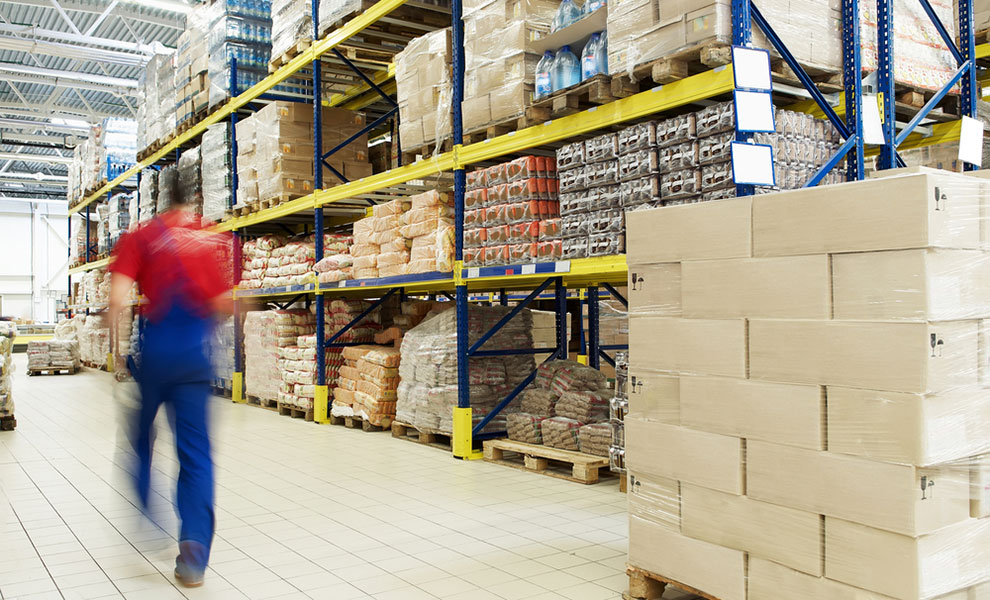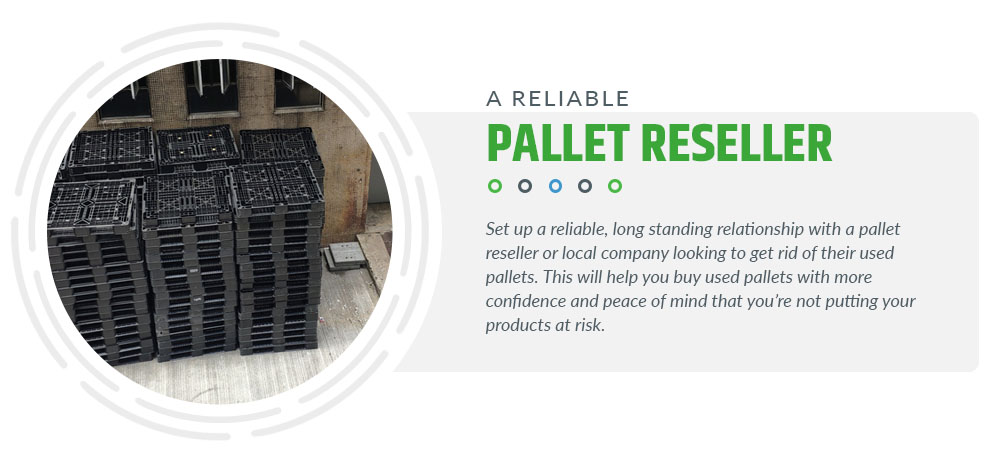The mighty pallet can do no wrong. They have become an essential component of the warehousing industry, helping workers and carriers transport goods quickly and safely. But every industry comes with its own considerations. If you own or manage a food processing plant, you need to use caution when bringing shipping materials into your facility. The wrong purchase can lead to the spread of debris, bacteria and poor air quality, making it that much harder to get your products out the door.
Plastic Pallets for Sale Are Best for Food Processing Plants
Learn how to safely reuse your pallets in the food processing industry, so you can save money on every order without worrying about contaminating your goods.
Using Pallets in the Food Processing Industry
Before you start lining your facility with pallets, you need to make sure your shipping materials are considered safe to use.
It’s best to use food-grade containers and shipping materials, including pallets. These materials are specifically designed to be around food. They are made with non-toxic plastic, so they won’t alter the integrity or safety of your food and beverage products. The Food and Drug Administration oversees the use of food grade containers. Visit their website to see a list of all the products and materials that qualify as food-grade.
You might think using a non-food-grade pallet isn’t that big of a deal, considering the food usually doesn’t come in contact with the pallet, but this is a common mistake. It’s best to streamline your entire operation by using the same kinds of materials and containers.
The Problem with Wood Pallets
When shopping for a pallet, it usually comes down to plastic vs. wood.
While wood pallets are often less expensive upfront, they tend to fall apart fairly easily over time. They are usually assembled in just a few minutes, using a few slabs of wood and some nails. All that slamming, shifting and turbulence can wear away at the pallet’s structural integrity, making them less reliable on the road. A used wooden pallet can easily snap apart when you least expect it, disrupting the supply chain.
With wood and nails, the dimensions can easily change over time. Wood is prone to warping. Moisture may cause parts of the pallet to expand, creating an uneven surface. This makes handling and transportation a challenge. The pallet may no longer fit in the designated space. Warping can also make your shipments unstable. They may fall or sway if the pallet isn’t level with the ground.
Wood can also easily split apart on the road. When using wooden pallets, there are bound to be plenty of wood chips lying around. Your workers may have trouble navigating your facility with all the debris on the floor. This can increase the risk of falls and accidents. These chips can also reduce air quality, spreading bacteria and pathogens through the air. The more debris lying around your warehouse, the harder it will be to breathe.
Plastic pallets are much more durable than those made of wood. The plastic retains its dimensions trip after trip, so it will always fit in the same spot. You don’t have to worry about tripping over wood chips and other forms of debris. Plastic pallets are essentially unbreakable, helping you keep your facility clean.
This doesn’t mean wood pallets are completely off limits. But, if you plan on choosing this option, keep these questions in mind to make sure they are safe to use around food:
How Were They Treated?
Wood pallets are often treated with toxic chemicals. This is because the U.S. Department of Agriculture requires manufacturers to treat their wooden pallets before letting them in the country. This prevents the spread of wood-borne pests and bacteria that can lead to disease and infestation.
When shipping your products overseas, your wooden pallets will need to pass inspection to make sure they have been treated as required by law. This can be a logistical nightmare, especially if you are trying to get hundreds, if not thousands, of wooden pallets through customs.
Wood pallets are either heat-treated, which means heating up the wood in a kiln until it seals, or they are treated with a chemical solution known as methyl bromide, considered toxic to humans. In the interest of safety, wooden pallets treated with methyl bromide shouldn’t be allowed anywhere near your food and beverage products. To find out how your pallets have been treated, look for the IPPC (International Plant Protection Commission) stamp for more information. It will either be labeled with a “HT” for heat-treated or “MB” for methyl bromide.
Use Stack Racks to Keep Your Food Processing Plant Organized
Considering the chemicals used to treat some wooden pallets, it’s best to leave them out of your food processing plant. Even if your pallets aren’t coming in contact with the food, they can spread debris and bacteria that may wind up in your products without your knowledge.
Plastic pallets, on the other hand, do not need to be treated. They are made with food-grade plastic so they come off the assembly line ready-to-use.
How Were They Used?
Finding out how, or if, the pallets were treated is only one step of the equation. Just because the wood pallet was heat-treated doesn’t mean it’s safe for food processing.
Research the life of the pallet to learn more about how it was used by the previous owner. Wood is considered extremely absorbent. Chemicals, residue, food and other products can easily imbed themselves in the fibers of the wood. Talk to the previous owner about how these pallets were deployed and what kinds of products and containers they once held.
Get a sense of where they stored the pallets. Leaving wooden pallets out on the loading dock for days on end can also be a hazard. The wood may warp or attract mold and bacteria in moist conditions. Be sure to keep your pallets inside to make sure you can reuse them again and again.
Some companies may be hesitant to give out too many details which is why it’s usually better to stick with a reliable container reseller. In many cases, the reseller will request this information from the original owner, so you don’t have to worry about hunting down answers to your questions.
It’s always best to invest in used pallets that were used to transport food and beverage products. This shows you they are safe to use in your facility. However, don’t just take the previous owner’s word for it. Do some research on your own to make sure you’re investing in the right kind of pallet.
Set up a reliable, long standing relationship with a pallet reseller or local company looking to get rid of their used pallets. This will help you buy used pallets with more confidence and peace of mind that you’re not putting your products at risk. Look for plastic pallets for sale online to expand your search and so you can lock in quality materials at the lowest possible price.
Can You Clean Them?
If you recently bought wood pallets that are suspect, you may decide to simply scrub the bacteria away. But cleaning off wood pallets is often a fool’s errand. Again, wood is extremely absorbent and porous, which means the bacteria doesn’t just sit on the surface–it’s embedded in the fibers of the wood. You can’t just throw some vinegar and soap in a bowl and start soaking the wood. In fact, this might make the problem worse.
You may try treating your wooden pallets again to remove any leftover bacteria, but this will be expensive which usually defeats the purpose of buying pallets in the first place. It’s also not clear if heating or sealing the wood would make them any safer. This method only works if the pallet is fresh off the assembly line; otherwise, you’re just sealing the bacteria into the wood instead of expunging it.
Plastic pallets are much easier to clean. The plastic is non-absorbent so you don’t have to worry about anything embedding itself in the plastic. Just wash off the surface with soap, detergent or vinegar and the pallet should be good to go.
How Will You Use Them?
Different kinds of pallets often serve different purposes in the warehouse. Consider how you plan on making use of your pallets before handing your money over to the seller.
Generally, the closer your pallets are to your food and beverage products, the safer they need to be. If your pallets are meant to house and protect your food-grade containers, it’s best to use food-grade plastic pallets. But if your pallets are meant to just sit on the loading dock, you might be able to get away with using wood, as long as they stay away from anything meant for human consumption.
You’ve probably seen photos and videos of people turning used wooden pallets into furniture and makeshift storage containers. Avoid having your employees sit on the pallets if they have been treated with dangerous chemicals. They should also use gloves when handling the pallets to reduce the chances of contamination.
Consider where you will store the pallet. Most facilities will use stack racks to keep their pallets upright and off the ground, which keeps them out of the way.
Think about what kinds of containers will go on the pallet. It’s best to use the same kind of material as the shipping container. For example, if you use a plastic bulk collapsible container, attach it to a plastic pallet for more consistency.
How to Reuse Your Pallets Safely
Now that you understand the differences between wood and plastic pallets, you should have a better idea of what’s best for your food processing plant.
Regardless of what kind of pallet you choose, use these tips to extend the life of your shipping materials so you can reuse them for years to come.
- Keep your pallets in a dry, room-temperature location whenever possible to prevent exposure to the elements.
- Clean off your pallets before and after every trip.
- Consider wrapping your pallets when shipping in bulk to make sure the load stays together. Learn how to wrap a pallet for more stability and control on the road.
- Always use your pallets according to the manufacturer’s guidelines. Avoid tossing, slamming or stomping on your pallets to keep them in good condition.
- The load should always adhere to the exact dimensions of the pallet. Do not overload the pallet or shift the weight too much to one side to prevent the shipment from toppling over.
- Be sure to inspect your pallets before and after each trip. Watch out for knicks, dents and other signs of wear and tear. Get in the habit of taking damaged pallets out of rotation.
- Talk to your business partners about these safe handling guidelines to make sure your pallets are handled with care throughout the supply chain.
As you can see, there’s a lot to consider when shopping for used pallets. While most wood pallets are treated, be sure to only use those that have been heat-treated to avoid contaminating your food products. Regardless of how they were treated, it’s usually best to go with plastic pallets in the food and beverage industry. They are easier to reuse and maintain without spreading as much debris.
Your customers trust you to keep your food and beverage products safe from contamination. One simple mistake can lead to product recalls and health and safety issues, all of which may damage your reputation in the industry.
If you’re still not sure whether you should use wood or plastic pallets, conduct a life cycle assessment comparison of wooden and plastic pallets in the grocery industry.
Keep this information in mind to find the right reusable pallet for your food processing plant.
Image Credits
Abert/shutterstock.com
3DMAVR/shutterstock.com
YW.Bruce/shutterstock.com
Siwakorn1933/shutterstock.com
KORN25/shutterstock.com
Dmitry Kalinovsky/shutterstock.com
Pictures_n_Photos/shutterstock.com








